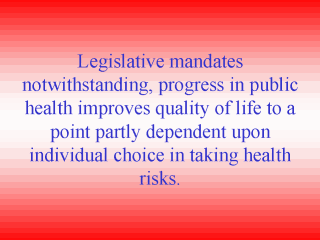 |
The well-being
and health of the public and private sectors converge in insurance rates that are based on
risk assessment. Risks quantify the effects of various physical, social, occupational, and
environmental hazards on mortality or life-expectancy. The costs of individual health
habits (such as smoking) are distributed among the general public in the form of higher
insurance premiums and more expensive medical care. Not only access to health care
services, but the general quality of life, health habits, and lifestyle have been shown to
affect the level of being at risk for a particular illness. Many diseases can be prevented
by changing lifestyle patterns or health habits. The premium provisions of the 1991 Health
Insurance Act of Russia attempted to grapple with these factors by linking individually
chosen health practices to premium costs, providing incentives for changing lifestyle
patterns and preventive medical care. |
